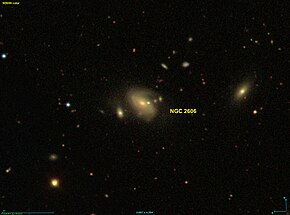The topic of this article may not meet Wikipedia's notability guideline for astronomical objects. Please help to demonstrate the notability of the topic by citing reliable secondary sources that are independent of the topic and provide significant coverage of it beyond a mere trivial mention. If notability cannot be shown, the article is likely to be merged, redirected, or deleted.Find sources: "NGC 2606" – news · newspapers · books · scholar · JSTOR (April 2024) (Learn how and when to remove this message)
| NGC 2606 | |
|---|---|
 | |
| Observation data | |
| Constellation | Ursa Major |
| Right ascension | 128.9 degree |
| Redshift | 0.044730 |
| Heliocentric radial velocity | 13,305 km/s |
| Distance | 648 Mly |
| Apparent magnitude (V) | 17.02 |
| Characteristics | |
| Type | Sbc |
| Size | 205,400 ly |
| Other designations | |
| PGC 24117, Z 263-59, MCG+09-14-072, NVSS J083534+524720 | |
NGC 2606 is a spiral galaxy in the Ursa Major constellation.[1][2][3] It lies 648 million light-years away from our home galaxy, the Milky Way.[2] The galaxy was first discovered by John Herschel, a British astronomer on 16th February 1831.[4] According to SIMBAD database, it is classified as a LINER galaxy[5] and a Seyfert type 2 galaxy by Hyperleda.[6]